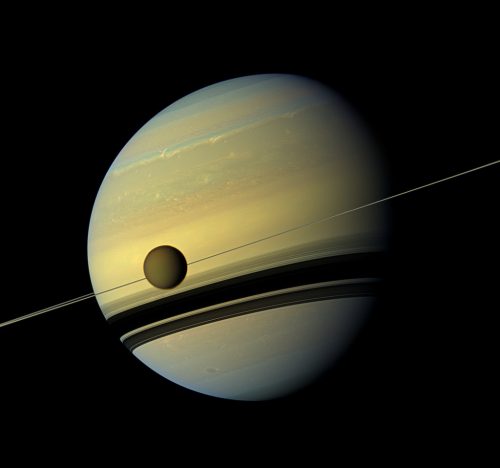On September 15th, 2017, NASA’s Cassini spacecraft ended its two-decade-long mission. The probe gathered important information about the atmospheric composition of Titan, Saturn’s largest moon. Titan is the only other planetary body we know of besides the Earth with a nitrogen-rich atmosphere. As such, its atmospheric chemistry and composition has been a subject of much scientific investigation.
The Cassini-Huygens satellite mission identified benzene, a molecule comprised of a six-membered carbon ring, in Titan’s atmosphere. This discovery raises the question of how other more complex polycyclic aromatic hydrocarbons (PAHs), which contain multiple benzene subunits, might also be formed in the stark, cold atmosphere of Titan. PAHs are implicated in reactions that form complex organic molecules that contribute to the orange-brown haze of Titan’s atmosphere. Previous descriptions of PAH formation on Titan invoke mechanisms observed in high temperature combustion models, which are inappropriate for Titan’s cold atmospheric conditions. Titan’s extremely cold atmosphere brings into question how PAHs may be formed there in the first place.
A collaborative team of scientists from Lawrence Berkeley National Laboratory (LBNL), University of Hawaii at Manoa, Samara University in Russia, and Florida International University, sought to answer this question. Previous findings from Professor Ralf Kaiser and Professor Alexander Mebel suggested that low temperature formation of naphthalene, a larger PAH, from benzene is a plausible mechanism. They proposed that the reaction proceeds through a novel hydrogen abstraction—a vinylacetylene addition mechanism at temperatures as low as those found on Saturn’s moon. In contrast to combustion mechanisms that form PAHs, their proposed mechanism can operate at temperatures around 70 K, or –334 °F. “There must be other reaction mechanisms to account for the formation of PAHs but [the community doesn’t] know which mechanisms. Then we came up with the possibility that PAHs can be formed at low temperatures, which has been completely ignored,” said Kaiser.
To test this hypothesis experimentally, researchers used a chemical reactor at Berkeley Lab’s Advanced Light Source (ALS) to simulate Titan’s high energy atmospheric conditions. The researchers hypothesized that breaking larger aromatics like naphthalene apart into radicals with solar photons in the presence of smaller molecules like vinylacetylene might result in the formation of larger PAHs. After subjecting the naphthyl radical and vinylacetylene to the ALS reactor, the products of the reaction were detected by mass spectrometry coupled with photoionization, which differentiates between key structural isomers and molecules of different molecular weights. In the presence of vinylacetylene, they observed masses corresponding to PAHs with three benzene rings: anthracene and phenanthrene. These results indicate that that larger PAHs can be formed via molecular mass growth processes.
This surprising result sheds light on how these heavier PAHs might be formed on Titan. The authors further verified their experimental results with computational models to support their claims. These models showed that the formation of PAHs from the naphthyl radical and vinylacetylene is facile even at low temperatures. Together, these findings paint a new picture for reaction mechanisms under extremely cold conditions.
Professor Kaiser is enthusiastic about the implications that these mechanisms have for the field of astrochemistry. “We really hope that this will have a general acceptance,” he said. “Telescopes can identify molecules in space and this is really pretty cool. However, just from the identification you cannot really speculate how these molecules are formed. We need experiments based on hard-core physical chemistry.” Kaiser points out that exploring new mechanisms presents many opportunities for discovery in interstellar and solar system chemistry.
There are many possible extensions of this work. Professor Mebel notes that the formation of PAHs isn’t particularly significant to understanding how complex molecules related to life are formed, however, with an important caveat. “If you replace carbons with nitrogens, you get molecules related to nucleotides and nucleoside bases which are important parts of RNA and DNA,” he said. Thus, a broad application of this research is to study the formation of molecules relevant to the origin of life. Mebel comments that understanding how nitrogen gets incorporated into complex structures like PAHs is a challenging area of ongoing research. Understanding and describing new mechanisms in astrochemistry is a huge advance to the field, and the possibilities are out of this world.

